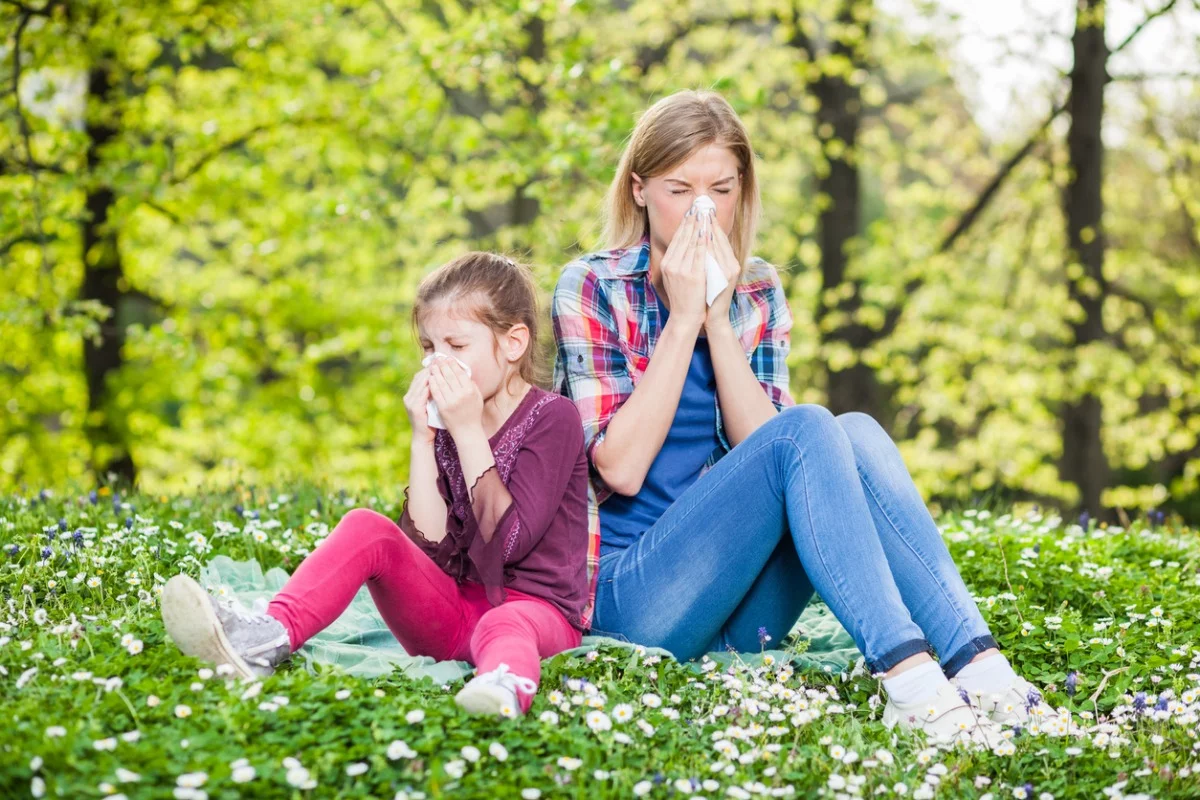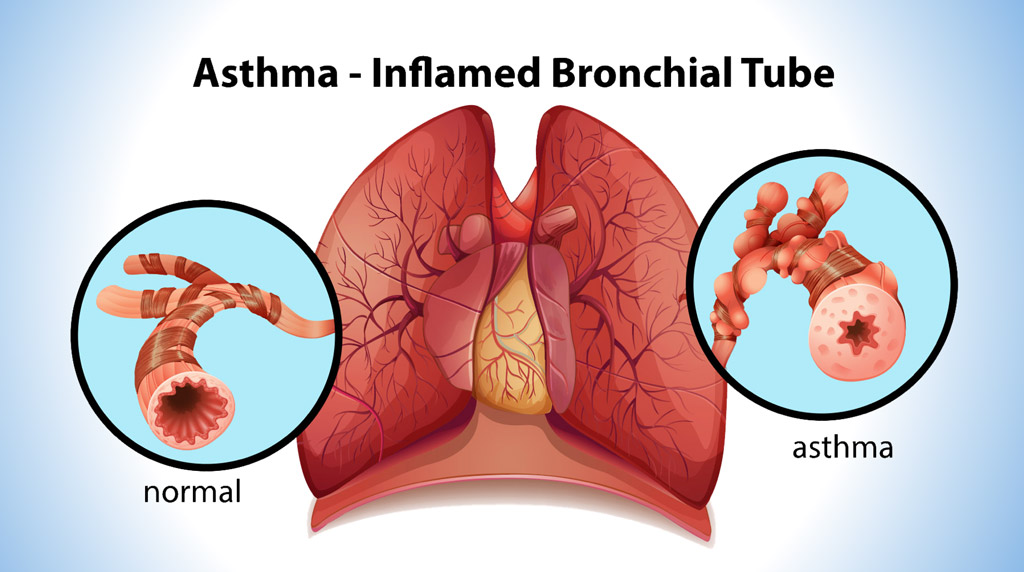Atopic asthma, Allergic Asthma
Root Cause of Disease
Airborne allergens, such as pollen, dust mites, mold spores, pet dander or particles of cockroach waste. Respiratory infections, such as the common cold.
Symptoms
An asthma attack that’s due to allergic asthma causes the same symptoms as other types of asthma. The difference is the trigger. Allergic asthma may also cause other symptoms that are linked to the allergy itself.
- Symptoms of an asthma attack include:
- Wheezing
- Coughing
- Chest tightness
- Rapid breathing
- Shortness of breath
Causes
An allergic reaction occurs when your immune system overreacts to the presence of a harmless substance called an allergen. Allergic asthma is when you develop breathing difficulties from inhaling allergens. It occurs when the airways swell as part of an allergic reaction.
Common allergens that can cause allergic asthma include:
- Pollen
- Mold
- Dust mites
- Pet dander (skin flakes)
- Cockroach droppings
- Rodents
You may notice that your allergy symptoms get worse during certain seasons due to increased pollen from trees, grasses, and weeds.
However, allergic asthma symptoms can occur year-round. This may be due to mold spores, which can grow indoors or outdoors on damp surfaces. Indoor dust mites feed on human skin cells and live in pillows, carpets, and other fabrics. And faces, saliva, dander, and other substances released by cockroaches, rodents, and pets can cause an allergic reaction in some people.
You might be surprised to learn that certain foods can cause an asthmatic reaction in a small number of people. Common food triggers include milk, shellfish, eggs, soy products, peanuts, gluten, tree nuts, and sesame seeds. Histamines and sulphites in alcohol products like beer and wine can also trigger asthma symptoms in some people.
Irritants such as air pollution, aerosol cleaning products, tobacco smoke, wood fires, and strong odours don’t cause an allergic reaction. But they may inflame your airways and make asthma symptoms worse.
Home Remedies to treat Allergic Asthma
Remedy – 1: Diet for asthma

While there is no evidence that a specific diet or group of foods prevents or treats asthma, improving your overall health through a healthy diet can have a positive effect. Asthma is a chronic inflammatory disease, which means that your immune system overreacts to non-harmful substances like pollen in your airways. While an inflammatory reaction can help protect you when a dangerous particle enters your body, it can also cause symptoms like swelling in your airways that can restrict your breathing. For this reason, it may help asthma symptoms to eat foods that fight inflammation. “I would recommend a whole food diet that is high in antioxidants, live cultures, and omega-3 fatty acids,”. This type of diet should include:
- Leafy greens like spinach and kale
- Berries like cherries and raspberries
- Whole grains like oats and brown rice
- Fatty fish like salmon and tuna
- Nuts and beans.
- Yogurt, sauerkraut, and other fermented foods
- Caffeine is found in coffee, tea, cola drinks and cocoa. Caffeine is a drug that is very similar to theophylline. Theophylline is a bronchodilator drug that is taken to open up the airways in the lungs and therefore relieve the symptoms of asthma, such as wheezing, coughing and breathlessness. Scientists are interested in finding out whether caffeine has the same effect on the lungs as theophylline.
Product link: Caffeine, Yogurt, Raspberries
Remedy – 2: Yoga

Procedure:
- Sit in a chair. Relax your neck and shoulders.
- Inhale slowly through your nose to the count of two. Keep your lips puckered, as if you’re about to blow out a candle.
- Exhale slowly through your lips to the count of 4. Release all the air from your lungs.
- Repeat until your breathing returns to normal.
Diaphragmatic breathing:
If you have asthma, your body must work extra hard to breathe. It reduces this effort by opening the airways, strengthening your abdominal muscles, and increasing your lung and heart function. This exercise may help soothe your asthma symptoms.
- Sit in a chair or lie down in bed. Place one hand on your belly so you can feel it moving in and out.
- Inhale slowly through your nose. You should feel your stomach move out, filling with air like a balloon.
- Exhale through pursed lips, two or three times longer than your inhale. Your stomach should move in as the air flows out.
- During this exercise, your chest should stay still. You can place your other hand on your chest to make sure it doesn’t move.
Remedy – 3: Turmeric
Materials: Turmeric

Fermented turmeric preparations, commonly sold as tea products, claim to have higher concentrations of biologically available, or absorbable, curcumin.
Procedure:
- Bring water or milk to a boil.
- Add the other ingredients to the boiling liquid.
- Steep for 10–15 minutes.
Product link: Turmeric
Other Remedies
Pomegranate peel Extract
Pomegranate peel extract is a natural substance sold in dietary supplement form. It is sourced from the peel of the pomegranate fruit. Pomegranate fruit is often touted as a top source of antioxidants including vitamin C. The use of dietary supplements containing pomegranate peel extract is said to provide a large range of health benefits including the treatment of asthma. Pomegranate peel extract contains ellagitannins, which are compounds known to reduce inflammation. This is a very crucial property and serves significantly in asthma treatment.
Green Tea
Green tea is considered by many to be nature’s healthiest beverage and is very rich in antioxidants that would help in asthma treatment. Green Tea is lower in caffeine than other caffeinated beverages and contains the amino acid L-theanine shown to induce relaxation and relieve stress which is one of the major emotional causes of asthma.
Hibiscus
Hibiscus is a plant said to offer several health benefits. Scientific research suggests that hibiscus tea or hibiscus extracts may offer antioxidant effects and this is significant in the elimination of allergens in asthma treatment.
Preventions
Allergic asthma attacks aren’t always preventable. However, you may be able to make them less frequent by changing your environment.
The steps you take will depend on the allergen(s) causing your symptoms. They may include:
- Washing bedding frequently in hot 130°F (54°C) water
- Mopping instead of sweeping
- Putting dust covers on pillows and mattresses.
- Removing rugs from rooms or using a vacuum with a HEPA filter
- Keeping windows closed during allergy season.
- Avoiding being outside as much as possible when pollen counts are high.
- Changing clothes and showering after spending time outdoors
- Keeping pets outdoors
- Bathing your pet weekly to remove dander.
- Cleaning bathrooms, your kitchen, and the basement regularly
- Keeping humidity in your home at between 30 to 50 percent
- Emptying garbage frequently and avoiding leaving food out, to avoid attracting cockroaches.
- Setting roach traps




